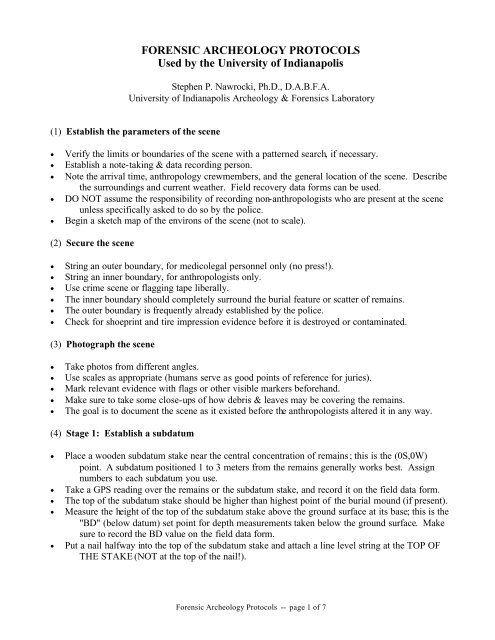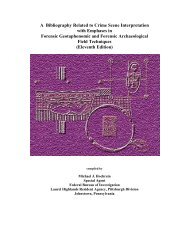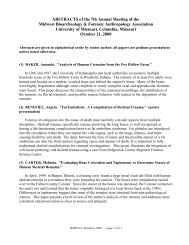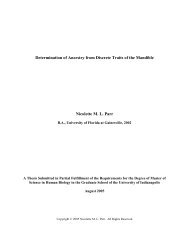Forensic Archeology Protocols Used by the University of Indianapolis
Forensic Archeology Protocols Used by the University of Indianapolis
Forensic Archeology Protocols Used by the University of Indianapolis
You also want an ePaper? Increase the reach of your titles
YUMPU automatically turns print PDFs into web optimized ePapers that Google loves.
FORENSIC ARCHEOLOGY PROTOCOLS<br />
<strong>Used</strong> <strong>by</strong> <strong>the</strong> <strong>University</strong> <strong>of</strong> <strong>Indianapolis</strong><br />
Stephen P. Nawrocki, Ph.D., D.A.B.F.A.<br />
<strong>University</strong> <strong>of</strong> <strong>Indianapolis</strong> <strong>Archeology</strong> & <strong>Forensic</strong>s Laboratory<br />
(1) Establish <strong>the</strong> parameters <strong>of</strong> <strong>the</strong> scene<br />
• Verify <strong>the</strong> limits or boundaries <strong>of</strong> <strong>the</strong> scene with a patterned search, if necessary.<br />
• Establish a note-taking & data recording person.<br />
• Note <strong>the</strong> arrival time, anthropology crewmembers, and <strong>the</strong> general location <strong>of</strong> <strong>the</strong> scene. Describe<br />
<strong>the</strong> surroundings and current wea<strong>the</strong>r. Field recovery data forms can be used.<br />
• DO NOT assume <strong>the</strong> responsibility <strong>of</strong> recording non-anthropologists who are present at <strong>the</strong> scene<br />
unless specifically asked to do so <strong>by</strong> <strong>the</strong> police.<br />
• Begin a sketch map <strong>of</strong> <strong>the</strong> environs <strong>of</strong> <strong>the</strong> scene (not to scale).<br />
(2) Secure <strong>the</strong> scene<br />
• String an outer boundary, for medicolegal personnel only (no press!).<br />
• String an inner boundary, for anthropologists only.<br />
• Use crime scene or flagging tape liberally.<br />
• The inner boundary should completely surround <strong>the</strong> burial feature or scatter <strong>of</strong> remains.<br />
• The outer boundary is frequently already established <strong>by</strong> <strong>the</strong> police.<br />
• Check for shoeprint and tire impression evidence before it is destroyed or contaminated.<br />
(3) Photograph <strong>the</strong> scene<br />
• Take photos from different angles.<br />
• Use scales as appropriate (humans serve as good points <strong>of</strong> reference for juries).<br />
• Mark relevant evidence with flags or o<strong>the</strong>r visible markers beforehand.<br />
• Make sure to take some close-ups <strong>of</strong> how debris & leaves may be covering <strong>the</strong> remains.<br />
• The goal is to document <strong>the</strong> scene as it existed before <strong>the</strong> anthropologists altered it in any way.<br />
(4) Stage 1: Establish a subdatum<br />
• Place a wooden subdatum stake near <strong>the</strong> central concentration <strong>of</strong> remains; this is <strong>the</strong> (0S,0W)<br />
point. A subdatum positioned 1 to 3 meters from <strong>the</strong> remains generally works best. Assign<br />
numbers to each subdatum you use.<br />
• Take a GPS reading over <strong>the</strong> remains or <strong>the</strong> subdatum stake, and record it on <strong>the</strong> field data form.<br />
• The top <strong>of</strong> <strong>the</strong> subdatum stake should be higher than highest point <strong>of</strong> <strong>the</strong> burial mound (if present).<br />
• Measure <strong>the</strong> height <strong>of</strong> <strong>the</strong> top <strong>of</strong> <strong>the</strong> subdatum stake above <strong>the</strong> ground surface at its base; this is <strong>the</strong><br />
"BD" (below datum) set point for depth measurements taken below <strong>the</strong> ground surface. Make<br />
sure to record <strong>the</strong> BD value on <strong>the</strong> field data form.<br />
• Put a nail halfway into <strong>the</strong> top <strong>of</strong> <strong>the</strong> subdatum stake and attach a line level string at <strong>the</strong> TOP OF<br />
THE STAKE (NOT at <strong>the</strong> top <strong>of</strong> <strong>the</strong> nail!).<br />
<strong>Forensic</strong> <strong>Archeology</strong> <strong>Protocols</strong> -- page 1 <strong>of</strong> 7
(5) Stage 1: Establish a datum<br />
• Measure and record <strong>the</strong> distance and compass direction <strong>of</strong> <strong>the</strong> subdatum stake from at least 2<br />
permanent landmarks. These will be your datum points. Assign letters to each datum you use.<br />
• Mark <strong>the</strong> datums so that <strong>the</strong>y can be found again easily; consider painting <strong>the</strong> side <strong>of</strong> a tree or a<br />
point on <strong>the</strong> road with fluorescent paint.<br />
• Telephone poles make good datum points, as each usually has a unique utility number stapled to it.<br />
• When in large fields that lack stable surface features, bury a large piece <strong>of</strong> scrap <strong>of</strong> metal as a<br />
datum so that it can be located later with a metal detector.<br />
(6) Stage 1: Lay out a baseline<br />
• If considerable vegetation, branches, or shrubs cover <strong>the</strong> scene, <strong>the</strong>y can be partially and carefully<br />
removed prior to constructing <strong>the</strong> baseline and reference grid.<br />
• Use <strong>the</strong> subdatum stake as one end <strong>of</strong> <strong>the</strong> baseline.<br />
• Hook <strong>the</strong> metal loop <strong>of</strong> a 30 or 50 meter tape on <strong>the</strong> datum nail and lead out <strong>the</strong> tape.<br />
• Shoot <strong>the</strong> tape to a specific compass heading (preferably a cardinal direction).<br />
• Alternatively, lay out <strong>the</strong> baseline for convenience and plot its compass bearing afterwards.<br />
• Because Indiana lies close to <strong>the</strong> magnetic meridian, correction for declination is not necessary.<br />
• Set a wooden endstake at some even distance from <strong>the</strong> first subdatum stake, far enough out to be<br />
workable. You can always extend <strong>the</strong> baseline in ei<strong>the</strong>r direction later if needed. The second<br />
stake can be given ano<strong>the</strong>r subdatum number.<br />
• Place chaining pins along <strong>the</strong> baseline at 1 meter intervals if a grid will be established.<br />
• Connect <strong>the</strong> 2 endstakes with string.<br />
• You can leave <strong>the</strong> tape in place for later reference.<br />
• A second baseline can be constructed perpendicular to <strong>the</strong> first and running through <strong>the</strong> subdatum.<br />
• If a transit is to be used, it can be assembled over one <strong>of</strong> <strong>the</strong> subdatums now.<br />
(7) Stage 1: Construct a reference grid<br />
• String grids are used for burials and compact surface scatters.<br />
• Extend <strong>the</strong> grid directly <strong>of</strong>f <strong>of</strong> <strong>the</strong> baseline; it does not necessarily have to include <strong>the</strong> subdatum<br />
stake.<br />
• Make sure that <strong>the</strong> grid is large enough to be workable (you can always add on later).<br />
• A 3 x 3 meter grid is good for a defined burial or compact scatter.<br />
• Use a hypotenuse table and 2 tapes to place <strong>the</strong> 2 <strong>the</strong> corner pins.<br />
• Place chaining pins at 1 meter intervals on <strong>the</strong> remaining 3 sides <strong>of</strong> <strong>the</strong> grid.<br />
• Use string to connect <strong>the</strong> tops <strong>of</strong> <strong>the</strong> 4 corner pins around <strong>the</strong> periphery <strong>of</strong> <strong>the</strong> grid. Then run string<br />
on <strong>the</strong> periphery at <strong>the</strong> ground level.<br />
• String <strong>the</strong> individual units within <strong>the</strong> grid at ground level, wrapping it around <strong>the</strong> chaining pins and<br />
allowing <strong>the</strong> lines to cross naturally in <strong>the</strong> center. Try to us a single string, minimizing<br />
doubling-back and cutting.<br />
• Chaining pins can be placed in <strong>the</strong> center where <strong>the</strong> strings cross (don't put pins into <strong>the</strong> remains!).<br />
• Fluorescent orange or green string is preferable for photographic purposes, and different colors can<br />
be used for different lines.<br />
• Each unit is numbered <strong>by</strong> <strong>the</strong> location <strong>of</strong> its SW corner relative to <strong>the</strong> subdatum stake. For<br />
example, (2S,2W) designates <strong>the</strong> unit whose southwest corner is located exactly 2 meters S and<br />
2 meters W <strong>of</strong> subdatum (0S,0W). The coordinate (2S,2W) <strong>the</strong>refore refers simultaneously to a<br />
1 square meter unit and also to <strong>the</strong> specific point on <strong>the</strong> ground surface at <strong>the</strong> unit's SW corner.<br />
<strong>Forensic</strong> <strong>Archeology</strong> <strong>Protocols</strong> -- page 2 <strong>of</strong> 7
The coordinate (2.74S,2.31W) would be a point that falls within unit (3S,3W), at a point that is<br />
exactly 2.74 m S and 2.31 m W <strong>of</strong> subdatum.<br />
• Subgrids consisting <strong>of</strong> larger blocks <strong>of</strong> units may be designated for convenience and numbered in<br />
some logical fashion.<br />
• Not all units must be strung. A grid <strong>of</strong> chaining pins without string, or with string on alternating<br />
lines can be very effective in certain circumstances.<br />
• Any point on <strong>the</strong> landscape can be tied into <strong>the</strong> coordinate grid system no matter how far from<br />
subdatum it lies or whe<strong>the</strong>r <strong>the</strong> grid is strung or not.<br />
(8) Stage 1: Begin detailed documentation <strong>of</strong> <strong>the</strong> scene<br />
• Photograph <strong>the</strong> baseline and <strong>the</strong> completed grid.<br />
• Begin a plan view diagram <strong>of</strong> <strong>the</strong> grid on graph paper.<br />
• Begin a pr<strong>of</strong>ile view diagram <strong>of</strong> <strong>the</strong> grid through <strong>the</strong> center <strong>of</strong> <strong>the</strong> burial (if present) and/or along<br />
<strong>the</strong> baseline.<br />
• Diagrams do not have to be incredibly detailed nor perfectly to scale as long as provenience data<br />
has been recorded on each item or feature.<br />
• Maps are NOT to be used to record detailed provenience data (that's what <strong>the</strong> field forms are for!).<br />
• Assemble evidence bags and collection equipment.<br />
• Record collected items, features, & basic measurements on <strong>the</strong> field recovery data form.<br />
(9) Stage 1: Take starting depths BD (below datum)<br />
• at points along <strong>the</strong> baseline;<br />
• at <strong>the</strong> intersections <strong>of</strong> 1m squares;<br />
• at each corner stake or pin;<br />
• at <strong>the</strong> center <strong>of</strong> <strong>the</strong> grid;<br />
• at any o<strong>the</strong>r pertinent points (e.g., <strong>the</strong> highest point <strong>of</strong> <strong>the</strong> burial mound or within depressions).<br />
• Record depth data on a field recovery data form.<br />
• A transit or line-level must be used to take depths.<br />
(10) Stage 1: Assign separate feature numbers<br />
• to <strong>the</strong> graveshaft;<br />
• to <strong>the</strong> burial mound, if present;<br />
• to <strong>the</strong> halo <strong>of</strong> disturbed earth, if present;<br />
• to <strong>the</strong> decomposition fluid stain in surface depositions (sometimes also present in shallow burials);<br />
• to rodent holes that are close enough to <strong>the</strong> remains to have impacted <strong>the</strong>m;<br />
• to water drainage channels;<br />
• to depressions or mounds caused <strong>by</strong> fallen trees;<br />
• to any o<strong>the</strong>r alterations <strong>of</strong> <strong>the</strong> landscape caused <strong>by</strong> humans or animals (e.g., holes caused <strong>by</strong><br />
cadaver dogs, shovel test pits created during search activities, campfires, exploratory windows<br />
dug <strong>by</strong> <strong>the</strong> archeologists into <strong>the</strong> grave, mounds <strong>of</strong> dirt caused <strong>by</strong> construction activities, etc.).<br />
• Feature numbers are not assigned to items <strong>of</strong> evidence.<br />
(11) Stage 2: Expose <strong>the</strong> surface <strong>of</strong> <strong>the</strong> grid<br />
• Scrape <strong>the</strong> surface <strong>of</strong> each unit with trowels into dustpans and <strong>the</strong>n into buckets.<br />
• Do not go deeper than about 1 to 2 cm into <strong>the</strong> topsoil.<br />
<strong>Forensic</strong> <strong>Archeology</strong> <strong>Protocols</strong> -- page 3 <strong>of</strong> 7
• Scraping should start in <strong>the</strong> more peripheral units, progressing inward towards <strong>the</strong> remains.<br />
• Similarly, scraping within a unit should start at its outside edge, moving inwards. This will ensure<br />
that hidden evidence is not kneeled on and that debris is not piled onto unexamined surfaces,<br />
fur<strong>the</strong>r burying evidence.<br />
• Screen each unit separately through 1/4" mesh, making sure to help <strong>the</strong> screeners keep track <strong>of</strong><br />
where each bucket came from.<br />
• Any evidence recovered during this stage is given an item number, bagged, and recorded in <strong>the</strong> log.<br />
• Establish a remote spot to dump screened refuse.<br />
• Make sure to keep an eye out for insect evidence, hair, and fibers.<br />
• When <strong>the</strong> grid is cleared, take photographs <strong>of</strong> all features and map in relevant boundaries.<br />
• Clear <strong>the</strong> entire grid before proceeding to Stage 3.<br />
(12) Stage 3: Excavate <strong>the</strong> remains<br />
• If <strong>the</strong> remains are not significantly buried (as for surface scatters), <strong>the</strong>n Stage 3 procedures are<br />
<strong>by</strong>passed.<br />
• If a burial mound is present, remove it in its entirety to <strong>the</strong> level <strong>of</strong> surrounding (undisturbed)<br />
ground surface before proceeding into <strong>the</strong> graveshaft.<br />
• Uncover <strong>the</strong> remains <strong>by</strong> removing all soil from within <strong>the</strong> burial feature.<br />
• If <strong>the</strong> position or depth <strong>of</strong> <strong>the</strong> remains is uncertain, a 15 x 15 cm window can be opened first.<br />
• Proceed <strong>by</strong> unit, and do not mix soil from different units (screen <strong>the</strong> material separately).<br />
• Work from <strong>the</strong> center towards <strong>the</strong> edges <strong>of</strong> <strong>the</strong> graveshaft, to preserve toolmarks.<br />
• Pedestal large objects on a tower <strong>of</strong> soil until <strong>the</strong>ir presence becomes unwieldy.<br />
• Small, shallow objects can be removed as <strong>the</strong>y are encountered if <strong>the</strong>y will get in <strong>the</strong> way.<br />
• Map and photograph <strong>the</strong> burial when <strong>the</strong> grave fill has been completely removed and <strong>the</strong> remains<br />
are completely exposed.<br />
• The undisturbed soil outside <strong>of</strong> <strong>the</strong> graveshaft should never be excavated unless <strong>the</strong> burial feature<br />
has been fully excavated first.<br />
• Always be alert for toolmarks in <strong>the</strong> walls <strong>of</strong> <strong>the</strong> graveshaft.<br />
(13) Stage 4: Collect <strong>the</strong> remains<br />
• A body still articulated with s<strong>of</strong>t tissues can be wrapped in a clean sheet and placed in a body bag.<br />
• Loose bones and o<strong>the</strong>r evidence should be bagged in paper sacks and transported in a large<br />
Rubbermaid container or in a body bag.<br />
(14) Stage 4: Collection <strong>of</strong> wide scatters using triangulation<br />
• For moderately-scattered evidence that is distributed no more than about 4 meters from <strong>the</strong><br />
baseline, a tape can be run <strong>of</strong>f <strong>of</strong> <strong>the</strong> baseline and eyeballed for perpendicularity. Record <strong>the</strong><br />
measurements from <strong>the</strong> stretched tape and on <strong>the</strong> baseline for your coordinate point.<br />
• It may be unwieldy to plot coordinate locations <strong>of</strong> evidence that is widely scattered, especially if a<br />
grid has not been constructed. Switch to triangular recording in <strong>the</strong>se cases as follows:<br />
• Use <strong>the</strong> 2 endstakes <strong>of</strong> <strong>the</strong> baseline as reference points. Make sure to record <strong>the</strong> distance between<br />
<strong>the</strong> stakes and record this value on <strong>the</strong> field data form.<br />
• Attach a long tape to each endstake and pull both tapes out to <strong>the</strong> evidence.<br />
• Record <strong>the</strong> 2 measurements, making sure to note which measurement came from which stake.<br />
• Record <strong>the</strong> direction from <strong>the</strong> baseline that <strong>the</strong> evidence lies (e.g., ei<strong>the</strong>r N or S <strong>of</strong> <strong>the</strong> baseline,<br />
since <strong>the</strong> tapes could be pulled in ei<strong>the</strong>r direction).<br />
<strong>Forensic</strong> <strong>Archeology</strong> <strong>Protocols</strong> -- page 4 <strong>of</strong> 7
• A team <strong>of</strong> 3 people works best with this method.<br />
• The triangular data can be converted later to coordinate grid data using trigonometry.<br />
• DO NOT take triangular measurements on any evidence found within an established grid! Use <strong>the</strong><br />
proper coordinate data instead, measuring <strong>of</strong>f <strong>of</strong> <strong>the</strong> strings <strong>of</strong> each unit.<br />
(15) Stage 5: Final cleanup<br />
• BEFORE scraping, take soil samples from below <strong>the</strong> thorax and abdomen areas, if needed.<br />
• Scrape at least 2 to 3 cm <strong>of</strong> soil from below <strong>the</strong> remains and screen it for evidence.<br />
• Make sure <strong>the</strong>re is nothing else buried in <strong>the</strong> floor <strong>of</strong> a graveshaft. Sink a shovel test pit (STP) in<br />
<strong>the</strong> center if you are unsure whe<strong>the</strong>r you have reached undisturbed soil.<br />
• Take a soil pr<strong>of</strong>ile from one wall <strong>of</strong> a graveshaft and record it on <strong>the</strong> field data form.<br />
• Take a soil sample <strong>of</strong>f-site for comparison purposes, at least 5 meters from <strong>the</strong> body in undisturbed<br />
soil.<br />
• Make sure that plant samples have been taken from <strong>the</strong> vicinity.<br />
• Record <strong>the</strong> times that all anthropologists leave <strong>the</strong> scene.<br />
GUIDELINES FOR ASSIGNING ITEM NUMBERS TO EVIDENCE<br />
An item number can be assigned to any one thing or group <strong>of</strong> things that possess some intrinsic<br />
property, such as a common provenience, <strong>the</strong> same material composition, or a common exposure to<br />
some o<strong>the</strong>r element (such as blood). The significance <strong>of</strong> <strong>the</strong> intrinsic property and its relevance to <strong>the</strong><br />
particular scene must be explained <strong>by</strong> <strong>the</strong> archeologist.<br />
Examples:<br />
(1) The skeletonized bones <strong>of</strong> a right hand are tightly clustered on <strong>the</strong> surface <strong>of</strong> one unit. They are<br />
collected and bagged under <strong>the</strong> same item number, with a single coordinate location measured to <strong>the</strong><br />
center <strong>of</strong> <strong>the</strong> cluster; OR<br />
(2) Multiple fragments <strong>of</strong> burned bone recovered in <strong>the</strong> screen during <strong>the</strong> sifting <strong>of</strong> a single<br />
stratigraphic layer are bagged under <strong>the</strong> same item number; OR<br />
(3) Numerous small clumps <strong>of</strong> stuffing from a sleeping bag have been dispersed over <strong>the</strong> grid <strong>by</strong><br />
carnivores. Their general locations are noted and photographed and <strong>the</strong>n <strong>the</strong>y are all collected in one<br />
bag under <strong>the</strong> same item number; OR<br />
(4) Numerous bones are widely scattered over <strong>the</strong> surface <strong>of</strong> a cornfield and plotted using<br />
triangulation. Each bone is given a separate item number, which is written directly on <strong>the</strong> bone in<br />
pencil or on a string tag that is attached to <strong>the</strong> bone. If <strong>the</strong> bone can be identified in <strong>the</strong> field <strong>by</strong> <strong>the</strong><br />
anthropologist (e.g., “left femur”), <strong>the</strong>n it does not have to be numbered or tagged as long as no o<strong>the</strong>r<br />
left femurs are present at <strong>the</strong> scene. All bones are <strong>the</strong>n placed in <strong>the</strong> same Rubbermaid container for<br />
transport; OR<br />
(5) A partially decomposed body with many bones still articulated <strong>by</strong> s<strong>of</strong>t tissues is lifted in its<br />
entirety into a disaster bag, being given a single item number; OR<br />
<strong>Forensic</strong> <strong>Archeology</strong> <strong>Protocols</strong> -- page 5 <strong>of</strong> 7
(6) During <strong>the</strong> excavation <strong>of</strong> a burial, a hyoid bone with a possible perimortem fracture is found at a<br />
shallow depth in <strong>the</strong> neck area. It is removed before <strong>the</strong> exhumation is completed to keep it from<br />
becoming damaged and is assigned its own item number.<br />
If <strong>the</strong>re is any possibility that trace evidence (such as hairs, fibers, or blood) could be artificially<br />
transferred from different pieces <strong>of</strong> evidence simply <strong>by</strong> being bagged toge<strong>the</strong>r, collect <strong>the</strong>m in different<br />
bags. However, our experience is that <strong>the</strong>se situations rarely apply to decomposed remains because<br />
<strong>the</strong>y are highly mixed and disturbed to start with.<br />
Evidence to be taken <strong>by</strong> police should be put in separate bags from <strong>the</strong> very beginning, to allow<br />
rapid transfer at <strong>the</strong> conclusion <strong>of</strong> <strong>the</strong> field recovery. In most cases, all evidence o<strong>the</strong>r than human<br />
remains and insects -- such as personal effects, clothing, and weapons -- should go directly to <strong>the</strong><br />
police. We frequently ask <strong>the</strong> evidence technicians to collect this evidence directly <strong>by</strong> <strong>the</strong>mselves<br />
(only after we have fully documented its provenience!), making <strong>the</strong>ir chain <strong>of</strong> custody easier to<br />
manage.<br />
It is a good idea to have an array <strong>of</strong> packaging materials ready for use, including coin envelopes,<br />
plain white paper (for wrapping hair or o<strong>the</strong>r trace evidence), newspaper, a variety <strong>of</strong> sizes <strong>of</strong> sturdy<br />
paper sacks and plastic ziplock bags, plastic garbage bags, aluminum foil, small plastic vials, small<br />
cardboard boxes, and Rubbermaid containers. Bags should be labeled in waterpro<strong>of</strong> ink on <strong>the</strong> lower<br />
half <strong>of</strong> <strong>the</strong> bag, to allow <strong>the</strong> top half to be folded down and stapled. The following information should<br />
be recorded on <strong>the</strong> bags:<br />
Case or Site #<br />
Date & Time<br />
Item #<br />
Brief Description<br />
Provenience (including Unit # & Feature #)<br />
Excavator's Initials<br />
TYPICAL ITEMS IN THE ARCHEOLOGIST’S TOOLKIT<br />
• large rocking screens with about 30" x 24" <strong>of</strong> exposed 1/4" wire mesh;<br />
• geological pan screens for finer sifting <strong>of</strong> insect evidence & very tiny items;<br />
• trowels;<br />
• line level & plumb bob;<br />
• large nails, wooden stakes, & chaining pins;<br />
• string (fluorescent orange, yellow-green, & white);<br />
• 30 to 50 m fiberglass tapes, 5 m pocket tapes, & folding rules;<br />
• plastic pails (as many as you can fit!);<br />
• dustpans & natural bristle brushes;<br />
• toothbrushes;<br />
• sharpened chopsticks or bamboo barbecue skewers (for excavating next to bones);<br />
• spoons <strong>of</strong> various sizes;<br />
• basic hand tools (hammer, pliers);<br />
• pocketknife;<br />
• compass;<br />
• field notebook with waterpro<strong>of</strong> paper & pencils, plus clipboards or a metal field desk;<br />
<strong>Forensic</strong> <strong>Archeology</strong> <strong>Protocols</strong> -- page 6 <strong>of</strong> 7
• root clippers & scissor-style grass shears;<br />
• small children's chalkboard & chalk, for making captions in photographs OR<br />
• whiteboard with marking pens;<br />
• plastic graduated north arrow, for scale in photographs;<br />
• flat and round-pointed shovels, rakes, and a metal t-probe;<br />
• plastic tarps & ropes;<br />
• photographic gear.<br />
Copyright © 1996 <strong>by</strong> Stephen Peter Nawrocki<br />
The author grants permission for this document to be copied and distributed for personal and<br />
educational use as long as proper citation is given. Commercial use <strong>of</strong> this document is forbidden<br />
without <strong>the</strong> prior consent <strong>of</strong> <strong>the</strong> author.<br />
Suggested citation <strong>of</strong> this document: Nawrocki S (1996). <strong>Forensic</strong> <strong>Archeology</strong> <strong>Protocols</strong> <strong>Used</strong> <strong>by</strong><br />
<strong>the</strong> <strong>University</strong> <strong>of</strong> <strong>Indianapolis</strong>. <strong>University</strong> <strong>of</strong> <strong>Indianapolis</strong> <strong>Archeology</strong> & <strong>Forensic</strong>s Laboratory<br />
(http://archlab.uindy.edu).<br />
Last update 6-27-06<br />
<strong>Forensic</strong> <strong>Archeology</strong> <strong>Protocols</strong> -- page 7 <strong>of</strong> 7








